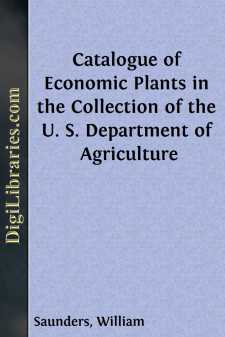Technology & Engineering
Technology & Engineering Books
Sort by:
THE MEN BEHIND THE MACHINES I MACHINES. AS SEEN FROM A MEADOW It would be difficult to find anything in the encyclopedia that would justify the claim that we are about to make, or anything in the dictionary. Even a poem—which is supposed to prove anything with a little of nothing—could hardly be found to prove it; but in this beginning hour of the twentieth century there are not a few of us—for...
more...
by:
William Saunders
DESCRIPTIVE CATALOGUE OF PLANTS. 1. Abelmoschus moschatus.—This plant is a native of Bengal. Its seeds were formerly mixed with hair powder, and are still used to perfume pomatum. The Arabs mix them with their coffee berries. In the West Indies the bruised seeds, steeped in rum, are used, both externally and internally, as a cure for snake bites. 2. Abrus precatorius.—Wild liquorice. This twining,...
more...
The year 1913 marks the close of the first fifty years since Abraham Lincoln issued that famous edict known as the emancipation proclamation, by which physical freedom was vouchsafed to the slaves and the descendants of slaves in this country. And it would seem entirely fit and proper that those who were either directly or indirectly benefited by that proclamation should pause long enough at this...
more...
MY EXCUSE My sixtieth birthday is a thing of yesterday, and I have, therefore, more than half descended the western slope. I have no quarrel with life or with time, for both have been polite to me; and I wish to give an account of the past seven years to prove the politeness of life, and to show how time has made amends to me for the forced resignation of my professional ambitions. For twenty-five...
more...
by:
Thomas Garnett
FACTS AND OBSERVATIONS ON THE SALMON. In the following observations I intend to offer some remarks on the various migratory fish of the genus Salmo; and then some facts and opinions which tend to show the importance of some change in the laws which are now in force regarding them. We have first the Salmon; which, in the Ribble, varies in weight from five to thirty pounds. We never see the fish here...
more...
by:
Anonymous
THE ART OF WARFARE "The Art of War, like every other art, possesses its theory, its principles; otherwise, it would not be an art."—MARSHAL FOCH. The Art of War, like any other art, is based upon certain fixed principles, and there is no short cut which hurries the student to his goal. The long and laborious line of study is the only safe way, and there are many pitfalls to be avoided on the...
more...
THEORIES OF TUITION Only eight years ago, in 1908, it was declared impossible for one man to teach another to fly. Those few men who had risen from the ground in aeroplanes, notably the Wright brothers, were held to be endowed by nature in some very peculiar way; to be men who possessed some remarkable and hitherto unexplained sense of equilibrium. That these men would be able to take other...
more...
CHAPTER I. Man's Duel with Nature Of all man's great achievements none is, perhaps, more full of human interest than are those concerned with flight. We regard ourselves as remarkable beings, and our wonderful discoveries in science and invention induce us to believe we are far and away the cleverest of all the living creatures in the great scheme of Creation. And yet in the matter of flight...
more...
First Dream. "Any fool can get into a hole."—Old Chinese proverb. "If left to you, for defence make spades."—Bridge Maxim. I felt lonely, and not a little sad, as I stood on the bank of the river near Duffer's Drift and watched the red dust haze, raised by the southward departing column in the distance, turn slowly into gold as it hung in the afternoon sunlight. It was just...
more...
ANNOUNCER In the year 1661 Connecticut received from the hand of Charles the Second a very liberal charter granting to the people of the colony almost complete self-government and to the colony an enormous stretch of territory extending westward to the Pacific Ocean. For fifteen years the colony prospered under the generous charter. Then in 1676 trouble arose with the Governor of New York, Sir Edmund...
more...











